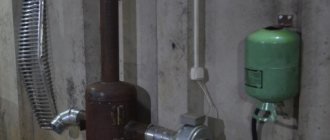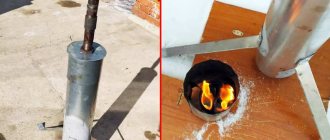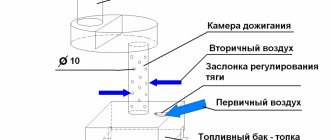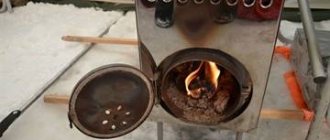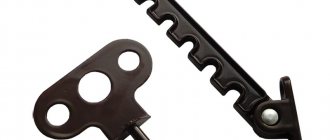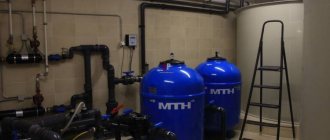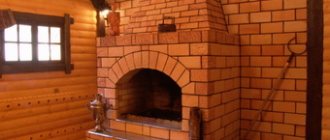In garages or workshops, in order to save money, they often install a working furnace instead of an expensive boiler: they process metal parts with their own hands, weld them and get a model that resembles a “potbelly stove.” However, when choosing a design for manufacturing, you may encounter difficulties. Do you agree?
We will tell you how to choose the optimal scheme and assemble an economical but very effective heating device yourself. The article we propose examines in detail popular options, the effects of which have been tested in practice. Advice is given on the construction and subsequent operation of the stove.
Types of homemade stoves in development
Engine oil contaminated with impurities will not ignite itself. Therefore, the operating principle of any oil stove is based on the thermal decomposition of fuel - pyrolysis. Simply put, to obtain heat, the waste must be heated, evaporated and burned in the furnace firebox, supplying air in excess. There are 3 types of devices where this principle is implemented in different ways:
- The simplest and most popular direct combustion design with afterburning of oil vapors in an open perforated pipe (the so-called miracle stove).
- Drip furnace using waste oil with a closed afterburner;
- Babington burner. How it works and how to make it yourself is described in detail in our other publication.
The efficiency of heating potbelly stoves is low and amounts to a maximum of 70%. Note that the heating costs indicated at the beginning of the article are calculated based on the indicators of factory heat generators with an efficiency of 85% (to get acquainted with the full picture and compare oil with firewood, you can go here). Accordingly, fuel consumption in home-made heaters is much higher - from 0.8 to 1.5 liters per hour versus 0.7 liters for diesel boilers per 100 m² of area. Take this fact into account when starting to manufacture a furnace for testing.
Design and disadvantages of an open-type potbelly stove
The pyrolysis stove shown in the photo is a cylindrical or square container, one-quarter filled with used oil or diesel fuel and equipped with an air damper. A pipe with holes is welded on top, through which secondary air is sucked in due to the chimney draft. Even higher is an afterburning chamber with a partition for collecting heat from combustion products.
The principle of operation is as follows: the fuel must be ignited using a flammable liquid, after which the evaporation of the waste and its primary combustion will begin, causing pyrolysis. Combustible gases entering the perforated pipe flare up upon contact with the oxygen flow and are completely burned. The intensity of the flame in the firebox is controlled by an air damper.
This stove has only two advantages during testing: simplicity and low cost and independence from electricity. The rest is all downsides:
- stable natural draft is required for operation; without it, the unit begins to smoke into the room and die out;
- water or antifreeze that gets into the oil causes mini-explosions in the firebox, causing fiery drops to splash from the afterburner in all directions and the owner has to put out the fire;
- high fuel consumption - up to 2 l/hour with low heat transfer (the lion's share of the energy flies into the chimney);
- The one-piece housing is difficult to clean from soot.
Although the potbelly stoves look different, they operate on the same principle; in the right photo, fuel vapors burn out inside the wood stove
Some of these shortcomings can be leveled out with the help of successful technical solutions, which will be discussed below. During operation, you should adhere to fire safety rules and prepare used oil - settle and filter.
Pros and cons of IV drips
The cardinal difference of this furnace is the following:
- a perforated pipe is placed inside a steel casing made from a gas cylinder or pipe;
- fuel enters the combustion zone in the form of drops falling to the bottom of a bowl located under the afterburner;
- To increase efficiency, the unit is equipped with air pressurization using a fan, as shown in the diagram.
Diagram of a dropper with bottom supply of fuel from the fuel tank by gravity
The real drawback of the drip stove is the difficulty of execution for a beginner. The fact is that you cannot rely entirely on other people’s drawings and calculations; the heater must be manufactured and configured to suit your operating conditions and the fuel supply must be properly organized. That is, repeated improvements will be required.
The flame heats the body of the heating unit in one zone around the burner
The second negative point is typical for supercharged stoves. In them, a jet of flame constantly hits one place in the body, which is why the latter will burn out quite quickly if it is not made of thick metal or stainless steel. But the listed disadvantages are more than offset by the advantages:
- The unit is safe to use because the combustion zone is completely enclosed by an iron casing.
- Acceptable waste oil consumption. In practice, a well-tuned potbelly stove with a water circuit burns up to 1.5 liters in 1 hour to heat 100 m² of area.
- It is possible to wrap the body with a water jacket and convert the exhaust furnace into a boiler.
- The fuel supply and power of the unit can be adjusted.
- Undemanding to the height of the chimney and ease of cleaning.
Boiler with pressurized air, burning waste engine oil and diesel fuel
Rules of operation and safety
No matter how much they talk about the safety of homemade stoves, they remain devices, improper handling of which can lead to burns or fire of surrounding objects. As a result, there are a number of prohibitions.
The following actions cannot be performed:
- use other types of fuel instead of used oil;
- use faulty equipment;
- install a heating device in a room without well-established ventilation;
- light a fire if the stove is not equipped with a smoke exhaust duct;
- block the hole in the burner;
- leave the room with the stove running for a long time;
- place flammable liquids or objects near the heated body;
- Spray oil or water onto the hot surface.
Only adults have the right to use the stove; children or animals are not allowed near it while the unit is operating.
As an interesting and original example of a stove under development, we suggest looking at the manufacturing technology of a potbelly stove. This is also a very effective model, available for self-production.
Important aspects of keeping your garage warm
Providing a traditional heating system in a garage is not easy, and it is also quite expensive, but maintaining optimal air temperature in such a building is still necessary. After all, it is even better to store transport at a temperature of at least +5 degrees, but some work needs to be done at a temperature of at least +18.
For the most part, car owners, as well as motorcyclists, prefer to use small, economical stoves to heat their garages, which are highly efficient and can warm up the room well.
It is also important that the stove not only saves the family budget, but is also safe and provides quick heating of the garage. It would be good if various wastes could also serve as fuel – for example, waste oil or wood waste. This will also make the furnace a less unprofitable structure.
This will also make the furnace a less unprofitable structure.
Heat loss in a garage is always high - it is rare that a building of this type is properly insulated with good thermal insulation materials
It is also important to understand that heating a small room often requires much more thermal energy than warming a house. To heat a two-story house, you will need a device with a power of about 10 kW, but a design with a capacity of 2.5 kW can heat a standard-sized garage. If you want to ensure that the temperature in the garage is always about 16 degrees, then you need to install a 2 kW unit
Sometimes, in order to save heat, motorists try to heat not the entire garage, but only the place where they directly work
If you want to ensure that the temperature in the garage is always about 16 degrees, then you need to install a 2 kW unit. Sometimes, in order to save heat, motorists try to heat not the entire garage, but only the place where they directly work.
A garage oven is an important piece of equipment that will create optimal conditions even in the cold season
Operating cycle: ignition, stop, cleaning
Before using the stove, it is necessary to prepare it.
Basic requirements for the condition of the heating apparatus:
- The stove must be installed strictly horizontally.
- It is not allowed to install the stove in places where there may be strong drafts.
- Do not use high stands or mount the unit on walls.
- The level of filled oil should not exceed two thirds of the volume of the lower chamber.
The oil itself does not burn, so third-party materials are used to ignite it. Ignition rules:
- a sheet of paper or rag is set on fire and dropped into the tank;
- flammable liquid is added to the tank and ignited using a burning filter;
When burning, heat is released in the chamber and the oil begins to boil. After about 10 minutes, the oil boils and vapors begin to evaporate. After ignition, the hole is covered halfway, and after heating the stove, it regulates the flow of air into the tank, ensuring even combustion of gases.
Oven maintenance boils down to regular cleaning of the internal surfaces. The stove is cleaned after approximately 5-6 fires. To clean it, you can use wire or a hammer, which taps all the walls. Then, you need to remove the top cover of the tank and remove all debris from it.
Scheme of a furnace for a garage under development.
Before cleaning the stove, you must close the chimney and drain the oil from the reservoir.
Finished furnaces undergoing testing
Russian furnaces using heavy oil and sludge products are sold - for example, Tunguska, KChM, Indigirka.
But the GeKKON boiler designed by Kurlykov is more popular. It is mass-produced, and testing is permitted by the list of fuel types recommended by the manufacturer.
The boiler operates as a flame bowl with an afterburning chamber. There is no automatic ignition of the stove, but the height of the chimney is not regulated, and the boiler burns extremely low-quality waste oil in full.
Self-production of this stove for sale will violate copyright.
Do-it-yourself waste furnaces can be very effective, especially if they are smartly built and refined. Sometimes it is possible to heat a house with such a stove, but the water jacket needs to be welded, which will turn the stove into a boiler.
It will need to be placed in a separate room to avoid contamination and smell, for example, in a barn (summer kitchen).
Arrangement of doors
Making a chimney I made a smoke exhaust structure from a 10-centimeter pipe.
Nothing supernatural - I simply welded the pipe to the hole in the center of the top of the body. The chimney led to the street through the wall to the roof. A piece of metal sheet was attached to the wall for fire protection. It is better to pass the pipe itself through the wall in a special fireproof glass.
Here you can see how the pipe goes through the wall
The stove is almost ready. The finishing touches remain. I cut an opening in the door of the lower chamber through which air can freely flow to the pan and the stove burner.
I riveted the thrust plates and assembled a simple lock for the top door. During the heating process, the stove body “leads”. To ensure that the combustion chamber remains airtight, the top door must close as securely as possible. That's why I made the castle.
Simple castle
I screwed several pieces of metal corner to the wall.
I installed the stove on the screwed corner. This is both convenient (if necessary, it will be much easier to carry out an inspection) and functional (heat loss into the ground is reduced).
Installed the stove
Types of furnaces for mining
It has already been said above that the simplest potbelly stove is not very convenient or effective. Therefore, various modification options have appeared, which we will consider below.
Exhaust stove from an old gas cylinder
Here you will also need 4 mm sheet metal (about 50 sq. cm), but another basic element is more important - a waste gas cylinder with a capacity of 50 liters, better than the old Soviet model, propane. Oxygen is heavier and more massive, making it difficult to work with. In addition, you need:
- steel pipe with a diameter of 100 m, a length of 2000 mm;
- valve with ½ inch thread;
- steel corner with shelf 50 mm, meter or a little more;
- clamps;
- loops;
- a piece of fuel supply hose;
- car brake disc. We select the diameter so that it fits freely into the cylinder;
- another cylinder (freon) to create a fuel tank.
Sequence of work:
- we drain the remaining gas from the cylinder, drill a hole in the bottom and rinse the cylinder with water;
- We cut out two openings in the side wall - a large lower one and a smaller upper one. The fuel chamber will be located in the lower one, and the afterburning chamber in the upper one. By the way, if the dimensions of the lower opening allow, in addition to mining, it will be possible to use firewood as fuel;
- We make the bottom of the afterburning chamber from a steel sheet;
- We make a burner from a pipe - a place where volatile gases mix with air and ignite. Holes are drilled in the burner (according to the principle described above), the inside of the pipe is GRINDED, this is necessary for greater efficiency of the product;
- the finished burner is welded into the bottom of the afterburner chamber;
- We make a waste tray from a brake disc and a piece of steel sheet. We weld the lid in its upper part;
- It is better to use a coupling to connect the burner and the pan cover - this makes servicing the stove easier;
- We provide a fuel supply. To do this, a hole is made in the wall of the cylinder into which a pipe with a threaded edge is welded;
- A valve is placed at the outer end of the pipe and a hose is connected to it. The hose, in turn, is connected to the fuel cylinder;
- the chimney pipe is welded into the upper part of the cylinder, then “taken away” in a smooth upward transition until leaving the room.
In fact, this completes the work with the furnace itself, but it is better to additionally build a heat exchanger - this will increase efficiency.
One of the heat exchanger options - plates welded onto the body - is shown in the photo below.
The finished oven with the doors open (the hinges were needed specifically for them; the pieces of the cylinder cut out in step 2 are attached to the hinges).
Pressurized furnace in operation
This design is also assembled on the basis of a 50-liter cylinder.
The air supply here comes from a fan (for example, from the stove of a VAZ 2108 car), which allows you to increase the draft in the afterburner and at the same time actually make the entire surface of the cylinder a heat exchanger.
The operation process and ignition are shown in the video.
Exhaust furnace with water circuit
Manufacturing a furnace with a water circuit can be almost the same as in the simplest version. The main difference is the organization of heat extraction into the water coolant. In the photo below, this possibility is realized by winding a pipe around the furnace body. In this case, cold water is naturally supplied from below, and heated water comes out from above.
A more “advanced” option is a stove with a “water jacket”. In fact, the body is enclosed in a second, hollow one, inside of which water circulates. The heated liquid is supplied to heating radiators.
True, the phrase “does not smoke” from the manufacturer is a bit of an exaggeration - this is only possible with regular cleaning of the chimney and the use of sufficiently high-quality, filtered fuel.
In the drawing, the device looks something like this.
Drip furnace
This type of stove is safer than those designs into which fuel is poured at once. In addition, in the case of gradual feeding, the burning duration can be freely adjusted.
A mandatory element of the system is a separate fuel tank, the waste from which is supplied in small portions - almost drops - using a special device.
The photo below shows a design where there is a separate tank with an oil line located above the fuel chamber. The base of the furnace is a gas cylinder; a valve is used to regulate the flow rate of the waste. The design of the furnace is discussed in more detail above.
Another type of product is with a retractable fuel compartment and a double afterburner.
It is realized in metal.
Please note: due to supercharging and the absence of fuel loss during filling, the exhaust consumption is reduced by 20...30%
Large thermal load
To heat water using this furnace, a sealed tank with coolant is installed above the upper reservoir. For water circulation, fittings are installed on the tank at different levels.
You can also make the furnace more efficient using a regular fan. It is installed near the upper tank. Blowing the container and the fan not only promote better circulation of warm air, but also cools the upper part of the stove. And this will significantly extend the service life.
Chamber separation
In a waste oil furnace, the combustion process occurs twice, i.e., you will need to equip two combustion chambers.
In the first chamber, the used oil burns slowly, producing flammable vapors. They enter the second chamber, where they are mixed with air. This combustible gas mixture burns in the second chamber, and releases a significant amount of heat, heating up to very high temperatures.
For proper operation of a homemade waste oil stove to work correctly, it is necessary to ensure air supply to both the first and second chambers. Where the waste burns, a control damper is needed, since the amount of incoming air must be moderate.
The second chamber can be provided with air by making a series of holes with a diameter of about 10 mm in the pipe connecting these two sections.
Burner device
An exhaust furnace consists of two containers connected to each other by a pipe. Thanks to the holes, the air necessary for combustion enters the unit. The lower reservoir is used for oil. It has an opening with a damper to increase or decrease the air flow into the chamber.
Drawing of a furnace being tested.
When waste is burned, vapors and gases are formed and enter the connecting pipe. Here the products of oil combustion are mixed with a large amount of oxygen. The gaseous waste from this process is discharged through the chimney.
Heater operation algorithm:
- Used oil is poured into the lower tank and ignited using any flammable liquid.
- After heating, the waste evaporates and begins to burn.
- The released pyrolysis gases are mixed in the afterburner with secondary air and burned in the upper tank, which has a partition.
- Combustion products exit through the chimney.
Bowl evaporator
Waste oil is a highly contaminated fuel that burns poorly. Therefore, for complete combustion, its heavy components must be separated from the light ones. For this, the flame splitting method (pyrolysis) is used.
There are two ways to initiate the pyrolysis process:
- The first method is to set fire to the oil in the fuel tank. Its temperature rises and evaporation begins. Next, the oil vapor mixes with the air entering through the neck of the tank. The splitting of waste and combustion of its light fractions is carried out in a pyrolysis combustion chamber, where excess oxygen is burned.
- The second method - instead of a tank with burning oil, a flame bowl and a special burner are used, which allows you to combine the pyrolysis, combustion and afterburning zones in the flame torch. A drop of oil falls on the hot surface of the bowl, evaporates, flares up and burns.
Homemade furnaces with drip oil supply are extremely rare, since their manufacture requires fundamental knowledge in the field of physics. In addition, experience in the manufacture of high-precision parts and the availability of special materials are required.
Fuel supply system
The drip supply of oil should be organized according to a 2-stage scheme, since a single-stage system can lead to unstable combustion or even an explosion. The two-stage scheme assumes the presence of a main oil tank, a valve, a supply dropper, a supply tank and a free drain.
A working dripper is located from the drain no lower than 60 mm from the bottom.
The fuel supply is opened when the kindling in the bowl (see below) is lit. While the oil drips into the tank to the level of the drain, you can adjust its flow, and then it drips into the bowl.
Drip furnace safe power supply diagram
But if you open the valve too much, the consumable will immediately fill, fuel will flow into the stove, and it will emit burning spray. It would be more correct to build a system for dropping oil into the stove with a safety valve and a metering capillary.
Since different metals are wetted by waste in different ways, and its properties change significantly, the length of the capillary will need to be selected: the oil is supplied under a gravitational pressure of 120-150 mm at room temperature, and the capillary is selected so that it drips more often, but with clearly visible drops.
Heat exchanger device
A heat exchanger is a device that transfers heat from one medium to another. The heat exchanger itself is not an independent device; it begins to work only when installed in any device.
To increase the efficiency of heat transfer, a specific type of heat exchanger with an optimal set of characteristics is selected for each device. Its efficiency depends on the design of the device itself and the material from which it is made.
Materials that are resistant to corrosion and have high thermal conductivity are used for heat exchangers. These include: aluminum, stainless steel, copper and its alloys, brass, cupronickel, titanium.
Exhaust furnace with water circuit
Waste oil furnaces with a water circuit heat water well. Thus, the room is heated by the furnace body and pipes in which the heated liquid circulates.
The advantages of such a unit:
- simplicity of design;
- does not smoke during operation;
- fire safety;
- economical in operation;
- independence from gas and electricity;
- easy to regulate room temperature;
- ease of ignition.
Installation of an exhaust furnace for a garage.
Flaws:
- chimney installation required;
- the chimney must be strictly vertical, without inclined sections;
- Every week you need to clean the stove and chimney; used oil must be purified.
The design of the furnace for mining with a water circuit consists of two chambers. They are connected by a pipe through which air is supplied. When heated in the lower tank, the fuel forms oil vapor. In the pipe it mixes with air, causing the combustion to become more intense. It burns in the upper chamber, and combustion products are discharged through a pipe.
Installation Tips
Installing a boiler that uses waste oil is practically no different from installing other types of heaters. There is one advantage: thanks to the presence of turbocharging and smokeless combustion of liquid fuel, the chimney does not have to be raised by 6-7 meters. It is enough to remove the chimney head from the wind pressure zone and raise it to a height of 4 m.
Regarding proper installation, we will give the following recommendations:
- The boiler and steel chimneys not protected by insulation are located at a distance of 0.5 m from combustible walls and other elements of a wooden house. The minimum distance from fireproof structures is 100 mm.
- Pass through the outer wall and the entire outer section of the flue with an insulated pipe - a sandwich, otherwise there will be a lot of condensation and soot. The chimney installation technology is described in detail in a separate material.
- Be sure to install a safety group on the heating supply line.
- Organize a good exhaust hood in the furnace to remove odors. Combustion air intake can be provided from the street.
- Equip the supercharger with a speed regulator and the oil line with a valve. This will allow you to control the power of the heat generator manually. Do not confuse the control valve with a regular tap; shut-off valves are installed on pipelines in any case.
- Make a primitive automatic emergency stop - install a thermostat on the supply, turn off the fan and the oil pump in case of overheating of the coolant.
If the waste is supplied by gravity, then for safety reasons it is advisable to install an electric shut-off valve on the fuel line. One subtlety: after an emergency shutdown, the boiler will not start on its own; you will have to light the oil manually or set up automatic ignition.
It is very advisable to insure the operation of the boiler in case of a power outage. A car fan, designed for a voltage of 12 volts, can be powered from a conventional battery, the rest of the equipment - pumps, thermostats - through an uninterruptible power supply unit.
The easiest way to supply used oil to the combustion chamber of the boiler is by gravity - from a container suspended from the wall. But such a system must be constantly monitored, plus as it is emptied, the interval between drops increases and the combustion intensity decreases.
Safety precautions
The stove is a device with an open fire, therefore, when operating it, it is necessary to strictly observe the necessary safety requirements:
- you need to ensure that there is no draft in the room where the unit operates;
- the oven temperature is quite high, so you should not leave anything nearby that could ignite;
- there should be nothing at a distance of 0.5 m;
- it is prohibited to operate a stove with obvious defects, this also applies to a chimney with damaged integrity;
- the operating unit must be kept under control, periodically checking its condition;
- Do not leave the oven unattended.
In addition, there are a number of requirements for the fuel on which the stove operates. Firstly, you cannot experiment with fuel using gasoline, kerosene and other flammable substances. This may cause an explosion!
Secondly, only used oil (motor, industrial, transmission, synthetic, etc.) should be used. Thirdly, the oil used as fuel should not contain water.
We make a heat generator from a cylinder
First of all, prepare the gas cylinders for welding - remove the spherical parts (don't forget to fill them with water first!) and cut one vessel to size so that together they form a body of the required height (1 m).
Prepare the remaining materials, taking into account the following recommendations:
- It is better to make the combustion chamber and flame bowl from stainless steel with a thickness of 1.5-3 mm (for example, grade 12X18H12T);
- if you couldn’t find stainless steel, use black steel grade St3 - St20 from 4 mm thick;
- Also select a stainless steel waste oil supply tube;
- wall thickness of flame tubes – at least 3.5 mm;
- to seal the top cover, select a 40 x 4 mm steel strip (rim) and an asbestos cord;
- prepare 3 mm sheet metal for the manufacture of an inspection hatch;
- For the heat exchanger, use pipes with a wall thickness of at least 4 mm.
The manufacturing process of a two-pass boiler during testing looks like this:
- Cut the Ø32 mm flame tubes to size and weld the heat exchanger using one cylinder as the outer casing and a Ø150 mm tube as the walls of the combustion chamber.
- Attach the water heating system supply pipes to the heat exchanger.
- In the second cylinder, cut holes for the inspection hatch and chimney pipe. Weld a Ø114 mm fitting and make a neck with a cover from sheet steel.
- Weld both tanks into one body. Make a shell of iron strip on top - it will serve as a seal for the lid. Fill the gap between the edges with asbestos cord.
- Make an afterburner in accordance with the drawing. Make holes in the hemispherical cover (formerly the end of the cylinder) for the viewing window and installation of the afterburner (in the center).
- Equip the lid with handles and a shutter on the window. The afterburner pipe can be tightly welded to it or screwed with bolts sealed with asbestos cord.
At the bottom end, the perforated pipe is closed with a plug, where 4 holes are made - one in the middle, the remaining three - radially. An oil pipeline tube is inserted into the central hole and scalded. The last step is to make a flame bowl of the boiler where the waste oil will burn.
Upon completion of assembly, weld an elbow with a flange to the afterburner pipe and install the “snail”. To prevent the outer metal wall of the water jacket from wasting heat in vain and heating the boiler room, insulate the body from non-flammable basalt wool. The simplest way is to wrap the insulation with twine and then wrap it in thin sheet painted metal.
The manufacturing process of an oil-fuel boiler is demonstrated more clearly in the following video:
DIY Projects
There are a great many options for manufacturing furnaces for mining. They are made from metal blanks or used containers (cylinders), with pyrolysis and turbo burners, with drip feed or blowing. We will focus on two popular models that are more suitable for independent design and assembly.
Sheet metal model
In garages and nearby areas you can often find unnecessary metal parts, cast iron plates, steel sheets, and pipes. Among them there will probably be several items suitable for welding a stove.
For example, to make a simple model you will need the following material:
- old steel sheet 3.5 mm thick;
- a piece of steel pipe with a wall thickness of 4.5 mm;
- tin pipe for chimney with a diameter of 110 mm.
In addition, you will need a tool that any garage owner usually has available: a welding machine with electrodes, a circular saw with cutting and grinding discs, a hammer, and pliers. A set of working protective clothing for welding work with goggles and gloves is required.
Before the welding process, we prepare some of the parts.
When some of the parts are prepared, we begin welding work, but we don’t put the circular saw far away - it can be useful for cutting out or cutting off individual fragments.
To prevent precipitation and debris from entering the chimney, we secure the cap at the end with self-tapping screws. The safe height of the chimney is about 4 m. Combustion products discharged above the roof will quickly dissipate in the atmosphere and will not harm people or plants.
After complete completion of the assembly and installation work, it is necessary to carry out testing and, if flaws are found in the work, try to correct them. We check the combustion quality in the following order.
During the design and welding process, the following errors may be identified:
- too thin walls of chambers and pipes (rapid wear, inability to retain heat for a long time);
- the hole is not large enough to fill oil and adjust the combustion force;
- poorly chosen location for installing the stove;
- different diameters of the stove pipe and chimney (you will have to use an adapter for connection);
- inaccurately adjusted dimensions of parts for welding (the seams will be loose and will not last long);
- ignition with gasoline - an explosion is possible, it is better to use solvents (White spirit and the like).
If you weld the stove according to the rules, it will last a long time and easily heat a room of 20-30 m². An article dedicated to this difficult issue will introduce you to options for organizing heating during testing.
How to make a stove from a gas cylinder?
The second option, which has become popular thanks to a successful assembly scheme, is a stove made from a regular gas cylinder, empty of contents.
You can connect a heat exchanger with a homemade air swirler and a fan to the body from the cylinder, and use a freon cylinder as a container for oil
First we draw up a diagram of the furnace.
Construction details: 1 – base of the body; 2 – perforated pipe; 3 – heat exchanger pipe; 4 – partition; 5 – visor; 6 – evaporator for oil; 7 – coupling; 8 and 10 – tube for feeding waste; 9 – ball valve; 11 – mining tank; 12 – swirler; 13 – fan
Cylinder volume – 50 l. The wall thickness of metal pipes is 4-5 mm, internal cross-section is 100 mm. To create a partition between the two chambers and make a visor, it is better to use pieces of metal sheet with a thickness of at least 4 mm. A brake disc is used as a reservoir for oil from which evaporation occurs.
The oil enters the evaporator through a ½ inch pipe. The part of the pipeline above the ball valve can be flexible to ensure ease of installation. A ball valve is installed so that it is always possible to shut off the fuel supply in an emergency. To manufacture the swirler, a pair of metal corners welded together was selected.
Next, we’ll look at how to make a compact waste oil stove for a utility room or garage.
In order for heated air to circulate throughout the room, it is necessary to install a heat exchanger. This is a steel pipe with a diameter of 100 mm. The most suitable place is inside the housing, between the burner and the flue pipe. To hold the flame, we weld a metal platform cut from a 4 mm sheet to the top of the heat exchanger.
We organize forced air supply using a duct fan. It can be made automatic by using a thermal relay. To better preserve heat, we place a swirler inside the pipe - a structure of two welded metal corners, the shelves of which are cut and deployed in the form of blades.
Then, from a freon cylinder, we make a tank for storing and supplying waste. The advantage of a tank of this design is a needle valve, convenient for adjusting the fuel supply
It remains to make two doors, each of which has nuances. The upper mandatory part is a strong lock that ensures reliable closure while the oven is operating. We make a gap at the bottom of the second door so that air can freely flow inside the housing and support the combustion of the oil.
After manufacturing the furnace, we carry out testing. Pour a little oil into the pan, then place a small piece of sponge soaked in solvent there. Set fire to the sponge. The oil heats up, begins to evaporate, and a flame appears in the burner.
We gradually feed the oil into the evaporator through the tube. If it is necessary to stop the combustion, shut off the exhaust flow (close both valves). As soon as the residues in the pan are burned, the combustion process will stop.
Schemes and rules for making a stove for mining from a pipe are given here. We recommend that you read the useful information.
How to make a stove
A homemade exhaust furnace for a garage is made in the following sequence:
Assembly of the lower chamber. In such a furnace, the primary combustion chamber and the fuel tank are combined. This is a round device, closed with a lid, in which holes are drilled for pouring oil and for installing a pipe - the second chamber of the furnace.
Parts for making a furnace for mining
The parts for the lower tank are cut according to the dimensions shown in the photo, the edges are cleaned with a grinder and welded. It is better to make the walls from a piece of pipe.
A bottom made of sheet metal is welded to them, and legs are welded from the corners. A cover with holes is cut out: one hundred millimeters in diameter in the center and 60 millimeters closer to any edge.
Tip: The lid should be removable, which will make it easier to clean the device and transport the oven.
- In a piece of pipe with a diameter of one hundred millimeters and a length of approximately 360 millimeters, holes are drilled for air intake with a diameter equal to one tenth of the diameter of the pipe. The holes must be spaced evenly across the diameter and height of the device.
- The pipe is welded to the lid of the lower tank. In this case, you need to control its perpendicularity of installation. An air damper is placed on the cover; it can be fixed with a rivet or with bolts. The diameter of the hole for mounting the damper is 60 millimeters. Oil is poured into the same hole and the stove is lit.
- The upper tank is assembled similarly to the lower one. For the body, a pipe with a diameter of 355 millimeters is taken. In the plate that will serve as the bottom, a hole with a diameter of one hundred millimeters is made, offset to the edge of the bottom. A small part of a pipe with a diameter of 110 millimeters is welded to it, which will be placed on the perforated chamber where the gases are burned.
- The lid of the upper tank is exposed to high temperatures, so it must be made of metal with a thickness of at least 6 millimeters. There is a hole in it for installing a chimney; it is located on the side opposite the hole at the bottom of the chamber. Between the chimney and the chamber wall, a cut-off device is welded to the top cover, which is a partition made of thick metal. The cutter should be located closer to the smoke exit hole.
- A chimney pipe is welded to the top cover, which is then connected to the chimney. To increase the rigidity of the structure, a spacer is welded between the chambers from a corner or a small diameter pipe.
- The stove can be painted with metal paint that can withstand high temperatures.
Necessary tool
When making a furnace for heating a garage with waste oil, you must prepare the following equipment and tools in advance:
- welding machine;
- welding electrodes of the required diameter;
- Bulgarian;
- electric drill;
- Grinder;
- hacksaw for metal;
- set of files;
- hammer;
- sledgehammer;
- pliers;
- chisel;
- paint brush;
- roulette;
- metal ruler;
- square;
- calipers;
- building level;
- plumb line;
- metal brush;
- emery cloth;
- pipe bending devices;
- metal scissors.
No. 1. Water heating system
The water heating system is organized in the garage by analogy with residential premises. The coolant is heated in the boiler, and then it passes through pipes and radiators, uniformly heating the entire garage room. After the heat supply stops, the pipes remain heated for another couple of hours. This is the main advantage of this system.
The main disadvantage is the complexity of the organization. In addition, the water in the heating circuit may freeze, so if the system will not be used in the coming days, it is better to drain the water. On the other hand, frequent water changes lead to rapid corrosion of pipes and radiators. To avoid this problem, it is better to use metal-plastic equipment. It is better not to use ordinary water in the heating system - it is replaced with antifreeze, a non-freezing coolant.
The complexity of the arrangement results in another drawback - the high price. The most economical way to heat a garage is to connect its circuit to a home boiler. The cost of general heating will increase, but it will still be cheaper than organizing an independent heating system.
If it is not possible to connect to your home system, you will have to install a separate boiler. It can run on different fuels. The following types of boilers are used in the garage heating system:
- An electric boiler is the easiest to install, extremely safe, but expensive to operate. Even if you are not worried about electricity bills, you should not use such boilers in areas with frequent power outages, power surges, or in regions with severe windy winters, because the wires may break, which will ultimately lead to freezing of the water in the system. If you do not manage to drain the water in time, the pipes may burst;
- gas boilers are used extremely rarely in garages, since not everywhere there is access to a gas pipeline. If the gas pipeline runs nearby, then you are very lucky - gas heating is inexpensive, and such systems are quite simple in terms of operation. The main thing is to follow safety precautions;
- boilers for liquid and solid fuel. You can choose a stove that runs on wood, coal, diesel or waste oil - it all depends on which resource is more accessible in your case. Solid fuel boilers require constant monitoring and frequent loading of fuel. Pyrolysis and pellet units are more convenient in this regard, but they are not cheap; the most economical option is a potbelly stove, which can also be used in a water heating system.
For all boilers, except electric ones, you will have to organize a chimney. In addition to the boiler, radiators, heating pipes and chimney pipes, you will need a circulation pump and an expansion tank. All this costs money, so using a hydronic heating system only makes sense in large garages. Often such heating is done at service stations and commercial auto repair shops. If the garage is small, then there is no point in organizing such a complex water heating system - this is an option for more or less spacious rooms where constant heating is required.
The operating principle of a water heating system is quite simple. The coolant heats up, passes through the pipes, gives off heat and returns to the boiler. The system can be one- or two-pipe. A single-pipe system is much easier to organize and cheaper; it is best suited for a small private garage. In this case, the heated coolant sequentially enters the radiators, i.e. in the first radiator the temperature will be higher than in the last, where the antifreeze reaches it already cooled down. The two-pipe system allows for more uniform heating, but much more materials will be needed.
Even if the garage is not attached to the house, but is located nearby, you can try to connect it to the home heating system, but there are limitations. The distance from the garage to the house should not be more than 20 m, and the pipes must be properly insulated.
If antifreeze is used as a coolant (a liquid that does not freeze even at -45C), then you must work with it carefully, because it is a toxic substance that becomes even more dangerous when heated. Antifreeze is not recommended for use in two-pipe systems
The coolant is replaced every 5 years.
How does an exhaust boiler work?
Heating a private house with a waste oil boiler is organized thanks to several important elements of the fuel supply, filtration and heat exchange system. The design contains the following components:
- Oil pump - connected to a preheating chamber and a filter that traps solid particles. Pump function, optimization of supply of waste quantity to the burner device.
- Preheating chamber - to reduce the percentage of underburning, used oil is preheated to a temperature optimal for combustion.
- Turbines - fuel is sprayed into the combustion chamber in the form of fine dust, while at the same time a stable flame is maintained. To operate, the simultaneous operation of two turbines, a combustion fan and a compressor is required.
- The controller is the heart of domestic oil recovery boilers. Ensures synchronous operation of all important components of heating equipment. Modern stations are connected to a remote control and warning unit and have a multi-level protection system that prevents emergency situations.
- Heat exchanger – depends on the type of boiler:
- Convection models - air heaters, do not have a heat exchanger at all.
- Domestic boilers for the home are equipped with one or two circuits connected to the heating and hot water system.
For use in domestic conditions, it is impractical and dangerous to install homemade heaters. It is allowed to connect exclusively factory-assembled boilers registered by Rostechnadzor.
An oil-fuel heating boiler for a private home or cottage, using waste oil, is economically beneficial for several reasons:
- Availability of fuel.
- Low cost of development.
The average calculation of the required amount of oil is calculated in the following way:
- Find out the maximum performance of the boiler; information is in the technical documentation.
- Divide it by 10.
- The result obtained is multiplied by 1000 50%.
The principle of boilers operating on recycled fuel is the same in all cases. It consists of evaporating the oil and burning the steam from it.
Principle of oil evaporation
But there are small nuances in this technology. All used oils contain many heavy metals, additives and other elements. The task is to build a unit that will allow you to accumulate heat inside, and not immediately discharge all these elements into the chimney. Complete oxidation of all elements occurs only if the maximum temperature inside the boiler is reached - 6000C.
The temperature indicator in this case is a very important point. Without going into lengthy explanations of chemical processes, we can say briefly: harmless combustion and evaporation of fuel can only occur at a temperature of 600 degrees. A deviation of 200 degrees to one side or the other will provoke the release of very harmful toxic substances.
Exhaust boiler with water circuit
Used oil is poured into the lower tank. The top layer of oil in the evaporation chamber heats up, resulting in the formation of steam. As it rises, it exits into a perforated pipe and connects with air, reaches the upper tank and burns. And the combustion products themselves are discharged through the pipe through the chimney.
Thus, the room is heated, but no toxic waste is released that is harmful to human health. This fact immediately answers the main question that interests many before building such a unit: “How harmful is a boiler during mining?”
Waste oil boiler diagram
You should clearly understand the operating principle and technology of oil evaporation in such a unit. It is not the oil itself that burns here, but its vapor. Due to the fact that the spent fuel heats up and begins to evaporate even before combustion begins, it becomes possible to decompose such burning fuel into lighter elements.
Where are similar heating units used?
- in production premises;
- in premises for keeping animals;
- in auto repair shops, service stations;
- in greenhouses;
- in warehouses and garages.
Almost any oil, including shock-absorbing oil, can be used as fuel for such a boiler.
Regular Maintenance
Waste oil, unlike diesel or gas, is a dirty fuel, even despite the presence of filters. Therefore, soot formation and contamination of the main working elements of the boiler are an order of magnitude higher. Lack of regular cleaning leads not only to a significant decrease in efficiency, but also to more serious problems.
So, waste oil boilers need cleaning:
- Internal walls of the heat exchanger (every 1-3 months). After turning off and completely cooling the boiler (after about 1 hour), using a metal brush, scraper, metal brush or any convenient tool, you need to thoroughly clean the surface. We also clean out the ash drawer.
- Burners (every 1-2 months). This point applies to standard boilers where a nozzle is used to spray fuel; it is this that needs to be cleaned. This can be done with a wire brush, cloth or sandpaper, depending on the degree of contamination. If the nozzle hole is clogged, you need to clean it with wire and blow it out well. Be careful and do not allow mechanical damage to the injector or change the factory diameter of its hole. It is also advisable to clean the air and oil supply pipes.
- Bowls (every 24-48 hours). This paragraph applies to vertical drip boilers. We turn off the boiler, wait until the fuel burns out, after which the flame sensor will work and the boiler will stop. Using a scraper and a wire brush, clean the bowl and remove the ash from the ash drawer. The cleaning process takes up to 5 minutes. Upon completion, we transfer the boiler to standard operating mode.
If the room is highly dusty, turbine fans must also be cleaned at least once a season. Detailed individual algorithms and requirements for regularity are always described in the boiler operating instructions.
How should the heating be in the garage?
For many motorists, the garage is almost a second home. Here they delve into their hobby, take a break from the hustle and bustle and take care of the car. Therefore, first of all, you should think about the comfort of the person who spends hours indoors.
Heating is also necessary for the car, because... low temperatures negatively affect its technical condition and significantly reduce its service life.
When it gets cold, the garage becomes too humid. Condensation forms on metal parts, which provokes corrosion processes. In a cold room, the car body quickly rusts and becomes unusable.
To keep the garage dry, you should take care of good waterproofing and ensure the normal operation of the ventilation system. However, moisture still gets into the room on the wheels of the car. It evaporates and drops of water settle on surfaces.
If there is no heating, moisture accumulates, causing fungus, mold, and rust to appear. To prevent this from happening, heating is necessary.
Low temperatures cause the oil to thicken and reduce battery capacity. This makes it difficult to start the engine and increases fuel consumption. Therefore, it makes sense to spend time and effort assembling a miracle stove
Features of garage operation determine the requirements for heating systems:
- Efficiency. The oven must heat the air quickly and maintain the desired temperature for several hours.
- Easy to use. When coming to the garage, its owner should spend a minimum of time and effort heating the room.
- Ease of maintenance. The stove must be inspected, cleaned, and repaired in a timely manner, so its design must be simple and understandable, and its parts must be easily replaceable.
- Availability of energy source. When choosing a heating system, fuel availability is of fundamental importance. A stove using diesel fuel, diesel fuel or waste oil is well suited for a garage.
- Safety. There is always some amount of flammable substances in the garage. Since these premises often serve as workshops and sheds, flammable materials will often be found here. Therefore, heating must comply with all fire safety standards.
- Cheapness. The costs of servicing a car and arranging a garage are already high, so saving on heating without compromising its quality is a pressing issue.
When choosing a suitable heating device, you should set priorities, because... the ideal is unattainable. The easiest to use are electric heaters. This energy source is available in almost any location.
However, the price of heating with electricity is too high, so it is worth considering other options.
There is a huge advantage in assembling a diesel stove with your own hands: you choose the design yourself and make a model that is ideal for specific operating conditions. You do not have to adapt the heating device or adapt to the peculiarities of its operation.
About useful modifications of an iron stove
There are several recommendations on how to make the above design even better. The first step is to strengthen the junction of the chimney pipe to the top slab, since this is the place that burns out most often. The reason is not only the high temperature, but also the load exerted on the weld by the chimney pipe. Typically, garage owners do not bother with separate mounting of the chimney and its entire weight rests on the top panel of the stove.
A wood-burning stove with 2 smoke circuits cannot boast of the size of the firebox, and therefore the duration of combustion. On the other hand, homemade long-burning stoves like “Bubafonya” are not the best option for a garage. They require a chimney at least 4 m high with good draft, which is not always feasible.
The heat transfer of a wood-burning stove can be improved if several vertical ribs are welded to the side walls, as shown in the photo below. A 4 mm thick strip or the same corner is used, thereby increasing the heat exchange area and increasing the efficiency of the heater.
The photo shows a cast iron stove with convection fins and a hob. A similar structure can be welded from steel
